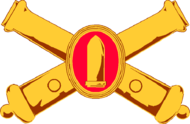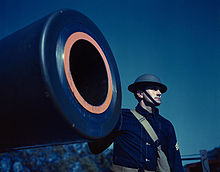- U.S. Army Coast Artillery Corps
-
U.S. Army Coast Artillery Corps 
Active 1901–1950 Country  United States
United StatesAllegiance  United States
United StatesBranch United States Army Patron Saint Barbara Colors Scarlet Mascot Oozlefinch Commanders Notable
commandersMajor General (Chief of coast artillery) Arthur Murray, Erasmus M. Weaver, Frank W. Coe, Andrew Hero, Jr The U.S. Army Coast Artillery Corps (CAC) was a Corps level organization responsible for coastal and harbor defense of the United States between 1901 and 1950.
Contents
History
Robert Fulton used the term "Torpedo" to describe the underwater explosive device in 1805. Samuel Colt experimented with electrical firing of the torpedo. Electrical fired torpedoes, later termed mines, fired from mine casemates ashore were associated with coastal fortifications.[1]
As early as 1882 the need for heavy fixed artillery for seacoast defense was noted in Chester A. Arthur's Second Annual Message to Congress where he noted:
"I call your attention to the recommendation of the Secretary and the board that authority be given to construct two more cruisers of smaller dimensions and one fleet dispatch vessel, and that appropriations be made for high-power rifled cannon for the torpedo service and for other harbor defenses."[2]Army leaders realized that heavy fixed artillery required different training programs and tactics than mobile field artillery. The Artillery Corps was divided into two types: field artillery and coast artillery. This process began in February 1901 with the authorization of 30 numbered companies of field artillery (commonly called batteries) and 126 numbered companies of coast artillery. 82 existing heavy batteries were designated coast artillery companies, and 44 new CA companies were created by splitting existing units and filling their ranks with recruits. The head of the Artillery Corps became the Chief of Artillery in the rank of brigadier general with jurisdiction over both types of artillery.
The coast artillery became responsible for the installation and operation of the controlled mine fields that were planted to be under observation, fired electrically and protected by fixed guns.[3] With that responsibility the Corps began to acquire the vessels required to plant and maintain the mine fields and cables connecting the mines to the mine casemate ashore organized as a "Submarine Mine Battery" within the installation command.[3] The larger vessels, Mine Planters, were civilian crewed until the creation of the U.S. Army Mine Planter Service (AMPS) and Warrant Officer Corps to provide officers and engineers for the ships designated as Mine Planters.[4][5] The mine component was considered to be among the principal armament of coastal defense works.[5]
Taft Board and creation of the CAC
In 1905, after the experiences of the Spanish-American War, President Theodore Roosevelt appointed a new board, under Secretary of War William Howard Taft. They updated some standards and reviewed the progress on the Endicott board's program. Most of the changes recommended by this board were technical; such as adding more searchlights, electrification (lighting, communications, and projectile handling), and more sophisticated optical aiming techniques. The board also recommended fortifications in territories acquired from Spain: Cuba and the Philippines, as well as Hawaii, and a few other sites. Defenses in Panama were authorized by the Spooner Act of 1902. The Taft program fortifications differed slightly in battery construction and had fewer numbers of guns at a given location than those of the Endicott program. By the beginning of World War I, the United States had a coastal defense system that was equal to any other nation.
The rapidity of technological advances and changing techniques increasingly separated coastal defenses (heavy) from field artillery (light). Officers were rarely qualified to command both, requiring specialization. As a result, in 1907, Congress split the Field Artillery Branch (United States), and Coast Artillery into separate branches, creating a separate Coast Artillery Corps (CAC), and authorized an increase in the Coast Artillery Corps to 170 numbered companies. In 1907 the United States Army Field Artillery School at Fort Monroe became the Coast Artillery School, which operated until 1946, and in 1908, the Chief of Artillery became the Chief of Coast Artillery.
By the end of the Second World War such fixed coastal defenses were obsolete and the artillery branches were merged back together in 1950[3] with some of the Mine Planter vessels being transferred to Navy and designated Auxiliary Minelayer (ACM / MMA).
Chief of Coast Artillery
The Office of the Chief of Coast Artillery was abolished 9 March 1942. with functions transferred to Commanding General, Army Ground Forces, effective 9 March 1942, by Circular 59, War Department, 2 March 1942.
Image Rank Name Begin Date End Date Notes Major General Arthur Murry 1 July 1908 14 March 1911 a[›] Major General Erasmus M. Weaver 15 March 1911 28 May 1918 a[›] Major General Frank W. Coe 24-may-1918 19 March 1926 a[›] Major General Andrew Hero, Jr 20 March 1926 21 March 1930 a[›] Major General John W. Gulick 22 March 1930 21 March 1934 a[›] Major General William F. Hase 26 March 1934 20 January 1935 a[›] Major General Harry L. Steele 21 January 1935 31 March 1936 a[›] Major General Archibald H. Sunderland 1 April 1936 31 March 1940 a[›] Major General Joseph A. Green 1 April 1940 9 March 1942 a[›] Units
In 1901, the regimental organization of the US Army artillery was abolished, more companies were added, and given numerical designations.
- 126 companies of heavy (coast) artillery
- 30 companies of light (field) artillery
In 1907 the Coast Artillery Corps was established and the Field artillery re-regimented
- 1st Field Artillery Regiment (United States)
- up to 320th
The coast artillery constantly reorganized the numbered companies until 1924. but during WWI created 61 regiments from the numbered companies, for service with the AEF. most of these were disbanded immediately after the war. In 1924 the Coast artillery Corps tried to go back to the regimental system, and numbered companies were returned to letter designations. (in order to promote some esprit-de-corps, the first 7 regiments were linked to the original 7 regiments of artillery).
- (16) Harbor defense regiments
- 1st Coast Artillery Panama
- 2nd Coast Artillery Panama
- 3rd Coast Artillery Los Angeles, San Diego, mouth of the Columbia.
- 4th Coast Artillery Panama
- 5th Coast Artillery southern New York
- 6th Coast Artillery San Francisco
- 7th Coast Artillery Sandy hook – Delaware
- 8th Coast Artillery Portland – Portsmouth
- 9th Coast Artillery Boston
- 10th Coast Artillery Narragansett bay – New Bedford
- 11th Coast Artillery Long Island Sound
- 12th Coast Artillery Chesapeake Bay
- 13th Coast Artillery Pensacola, Charleston, Key west, Galveston
- 14th Coast Artillery Puget sound
- 15th Coast Artillery Hawaii
- 16th Coast Artillery Hawaii
- (3) Tractor Drawn (155mm)
- 51st Coast Artillery Regiment (TD)
- 55th Coast Artillery Regiment (TD)
- 59th Coast Artillery Regiment (TD)
- (2) Railway regiments
- 52nd Coast Artillery (RY)
- 53rd Coast Artillery (RY)
- (5) Anti-aircraft regiments
- 60th Coast Artillery (United States) (AA)
- 61st Coast Artillery (United States) (AA)
- 62nd Coast Artillery (United States) (AA)
- 63rd Coast Artillery (United States) (AA)
- 64th Coast Artillery (United States) (AA)
- (2) Philippine Scouts
- 91st Coast Artillery (United States) (HD)
- 92nd Coast Artillery (United States) (TD)
In WWII more expansion and reorganization to the Battalion/Brigade system. more than 900 units created with the following titles-
- Coast Artillery Battalion
- Antiaircraft Artillery Battalion
- Antiaircraft Artillery Automatic Weapons Battalion
- Antiaircraft Artillery Gun Battalion
- Antiaircraft Artillery Searchlight Battalion
- Barrage balloon Battalions
and later
- Antiaircraft Artillery Missle Battalions.
See also
- Coats of arms of U.S. Air Defense Artillery Regiments
- Militia Act of 1903
- Seacoast defense in the United States
- Harbor Defenses of Manila and Subic Bays
- United States Army branch insignia
- List of United States Army installations in Panama
- List of major generals in the United States Regular Army before 1 July 1920
Notes
- ^ http://www.nps.gov/archive/fowa/torpedo.htm | National Park Service| Torpedo Defense – COAST DEFENSE OF THE POTOMAC
- ^ http://www.presidency.ucsb.edu/ws/index.php?pid=29523%7C Chester A. Arthur| Second Annual Message to Congress
- ^ a b c http://www.cdsg.org/reprint%20PDFs/CACorg2008.pdf | Coast Artillery Organization – A Brief Overview | Bolling W. Smith & William C. Gaines
- ^ http://www.usawoa.org/stivers2announced.htm | U. S. Army Warrant Officers Association| “LET GO!”
- ^ a b http://www.fortmiles.org/firepower/batteries/batt8.html | Ft. Miles | Principal Armament – Mine Field
References
- http://www.thecrimson.com/article/1919/4/26/government-plans-call-for-14-coast/
- Coast Artillery Journal on line [1]
- http://www.archive.org/stream/serviceofcoastar00hinerich#page/n7/mode/2up
- http://query.nytimes.com/gst/abstract.html?res=F20B17F93B5412738DDDA80A94D9405B838CF1D3
- http://historicalresources.net/ResearchTools/M728.pdf (Page 8)
- [2] artillery journal
- [3] company list
- [4] page 123, Coast Artillery Journal Number 59 August 1923
External links
- http://www.cdsg.org/CACunits.htm
- http://www.archives.gov/research/guide-fed-records/groups/392.html
- http://www.cdsg.org/reprint%20PDFs/CACinsignia.pdf
- timeline [5]
United States artillery of World War ITank guns Puteaux SA 18 · QF 6 pounder 6 cwt HotchkissSmall and pack guns Field, medium and heavy guns 3-inch M1902 field gun · Canon de 75 modèle 1897 · 4.7 inch Gun M1906 · Canon de 155mm GPF · Canon de 155 C modèle 1917 Schneider · BL 8 inch Howitzer Mk VI – VIII · 75 mm Gun M1916 · 75 mm Gun M1917Anti-aircraft guns 3-inch Gun M1918 · 75 mm Gun M1916Coast artillery guns 3-inch gun M1903 · 5-inch gun M1897 · 6-inch gun M1897 · 8-inch M1888 · 10 inch M1888 · 12-inch M1888 · 14-inch gun M1907 · 16-inch gun M1895 · 155 mm gun M1918MIRailway artillery 8-inch M1888 · 10-inch M1888 · 12-inch Gun M1895MIA1 · 14"/50 caliber railway gunUnited States artillery of World War IITank guns 37 mm gun M5/M6 · 75 mm gun M2/M3/M6 · 76 mm gun M1 · 3 inch gun M7 · 90 mm gun M3 · 105 mm howitzer M4Anti-tank guns Field, medium and heavy guns 75 mm howitzer M1 · 105 mm howitzer M2 · 105 mm howitzer M3 · 4.5 inch gun M1 · 155 mm howitzer M1918 · 155 mm howitzer M1 · 155 mm gun M1918MI · 155 mm gun M1/M2 "Long Tom" · 8 inch howitzer M1/M2 · 8 inch gun M1 · 240 mm howitzer M1Other vehicle-mounted Anti-aircraft guns Coast artillery guns 3-inch gun M1903 · 90 mm M1 · 6-inch gun M1903 · 155 mm gun M1918MI · 8-inch Mk. VI · 12-inch M1895 · 16-inch M1919 · 16-inch Howitzer M1920Railway artillery 8-inch Mk. VI · 8-inch M1888 · 14-inch M1920Categories:- Coastal fortifications
- Branches of the United States Army
Wikimedia Foundation. 2010.


